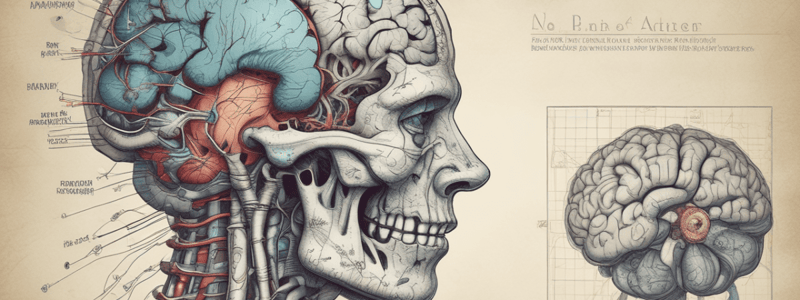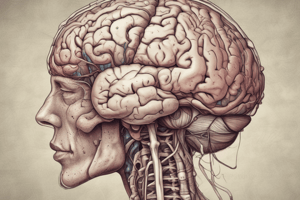Podcast
Questions and Answers
Which lobe is responsible for processing visual information from the eyes?
Which lobe is responsible for processing visual information from the eyes?
- Temporal lobe
- Occipital lobe (correct)
- Parietal lobe
- Frontal lobe
What is the result of damage to the parietal lobe?
What is the result of damage to the parietal lobe?
- Color blindness
- Deafness
- Astereognosis (correct)
- Phenomic paraphasia
Which lobe is involved in forming memories?
Which lobe is involved in forming memories?
- Temporal lobe (correct)
- Parietal lobe
- Occipital lobe
- Frontal lobe
What is the function of the primary visual cortex (V1)?
What is the function of the primary visual cortex (V1)?
Which lobe is divided into several visual processing areas?
Which lobe is divided into several visual processing areas?
What is the result of damage to the occipital lobe?
What is the result of damage to the occipital lobe?
Which lobe is responsible for two-point discrimination?
Which lobe is responsible for two-point discrimination?
Which lobe is located at the back of the brain, behind the parietal and temporal lobes?
Which lobe is located at the back of the brain, behind the parietal and temporal lobes?
What separates the temporal lobe from the frontal lobe?
What separates the temporal lobe from the frontal lobe?
What is the primary function of the parietal lobe?
What is the primary function of the parietal lobe?
What is the smallest lobe in the cerebral cortex?
What is the smallest lobe in the cerebral cortex?
Which lobe is responsible for voluntary movement?
Which lobe is responsible for voluntary movement?
What is the location of the frontal lobe?
What is the location of the frontal lobe?
What is the name of the famous case of frontal lobe dysfunction?
What is the name of the famous case of frontal lobe dysfunction?
How many primary lobes does the human brain have?
How many primary lobes does the human brain have?
Which lobe is involved in processing auditory information?
Which lobe is involved in processing auditory information?
What is the largest lobe in the cerebral cortex?
What is the largest lobe in the cerebral cortex?
Which lobe is responsible for processing visual information?
Which lobe is responsible for processing visual information?
What is the name of the structure that separates the parietal lobe from the frontal lobe?
What is the name of the structure that separates the parietal lobe from the frontal lobe?
What is the primary function of the cerebrum?
What is the primary function of the cerebrum?
What is the function of the brainstem?
What is the function of the brainstem?
How many layers does the cerebral cortex consist of?
How many layers does the cerebral cortex consist of?
What is the function of the diencephalon?
What is the function of the diencephalon?
What are the fundamental units of brain organization?
What are the fundamental units of brain organization?
What is the primary function of the cerebellum?
What is the primary function of the cerebellum?
What is the outermost layer of the cerebrum?
What is the outermost layer of the cerebrum?
What is the function of the thalamus?
What is the function of the thalamus?
What is the primary function of the hypothalamus?
What is the primary function of the hypothalamus?
How many categories can brain regions be broadly classified into?
How many categories can brain regions be broadly classified into?
What is the primary function of neural networks in the brain?
What is the primary function of neural networks in the brain?
How are sensory areas of the brain organized?
How are sensory areas of the brain organized?
What is the characteristic of neural networks shaped by anatomical pathways?
What is the characteristic of neural networks shaped by anatomical pathways?
What is the purpose of neural network models constructed from brain data?
What is the purpose of neural network models constructed from brain data?
What is the hierarchical organization of the brain network based on?
What is the hierarchical organization of the brain network based on?
What is the relationship between the composition of modules and the organization of the brain?
What is the relationship between the composition of modules and the organization of the brain?
What is the role of higher-level areas in the hierarchical organization of sensory areas?
What is the role of higher-level areas in the hierarchical organization of sensory areas?
What is the characteristic of the brain network exhibited through graph theory analysis?
What is the characteristic of the brain network exhibited through graph theory analysis?
What is the significance of understanding the organization of brain regions and neural networks?
What is the significance of understanding the organization of brain regions and neural networks?
What is the purpose of resting-state functional connectivity analyses?
What is the purpose of resting-state functional connectivity analyses?
Flashcards
Frontal Lobe Function
Frontal Lobe Function
Responsible for higher-order cognitive functions like planning, reasoning, and problem-solving, and also motor functions.
Frontal Lobe Location
Frontal Lobe Location
Located at the front of the brain, in front of other lobes.
Parietal Lobe Function
Parietal Lobe Function
Processes sensory information like touch, temperature, and pain; involved in two-point discrimination.
Parietal Lobe Location
Parietal Lobe Location
Signup and view all the flashcards
Temporal Lobe Function
Temporal Lobe Function
Signup and view all the flashcards
Temporal Lobe Location
Temporal Lobe Location
Signup and view all the flashcards
Occipital Lobe Function
Occipital Lobe Function
Signup and view all the flashcards
Occipital Lobe Location
Occipital Lobe Location
Signup and view all the flashcards
Phineas Gage
Phineas Gage
Signup and view all the flashcards
Astereognosis
Astereognosis
Signup and view all the flashcards
two-point discrimination
two-point discrimination
Signup and view all the flashcards
Primary visual cortex
Primary visual cortex
Signup and view all the flashcards
Visual Field Deficits
Visual Field Deficits
Signup and view all the flashcards
phenomic paraphasia
phenomic paraphasia
Signup and view all the flashcards
Executive Functions
Executive Functions
Signup and view all the flashcards
Lateral Sulcus
Lateral Sulcus
Signup and view all the flashcards
Central Sulcus
Central Sulcus
Signup and view all the flashcards
Cerebral Cortex
Cerebral Cortex
Signup and view all the flashcards
Primary Motor Cortex
Primary Motor Cortex
Signup and view all the flashcards
Study Notes
Lobes of the Brain
The brain is a complex organ, and its function is largely dependent on its structure. One of the primary ways the brain is divided is into lobes, which are regions of the brain that perform specific functions. The human brain has four primary lobes: the frontal lobe, parietal lobe, temporal lobe, and occipital lobe. These lobes are responsible for various cognitive functions, such as speech, perception, and memory. In this article, we will explore each of these lobes in detail.
Frontal Lobe
The frontal lobe is the largest lobe in the cerebral cortex and is located in front of the other lobes. It is responsible for various higher-order cognitive functions, including executive functions like emotional regulation, planning, reasoning, and problem-solving. The frontal lobe is also involved in motor functions, as it contains the primary motor cortex, which is responsible for voluntary movement. One of the most famous cases of frontal lobe dysfunction is that of Phineas Gage, a railway worker who survived an explosion that damaged his frontal lobe, resulting in changes in his personality and motor skills.
Parietal Lobe
The parietal lobe is located behind the frontal lobe, separated by the central sulcus. It plays a crucial role in processing sensory information, including touch, temperature, pressure, and pain. The parietal lobe is responsible for the ability to discern two-point discrimination, which is the ability to distinguish between a single touch and two separate touches on the skin. Damage to the parietal lobe can lead to astereognosis, a condition where individuals have difficulty recognizing objects by touch.
Temporal Lobe
The temporal lobe is located on the sides of the brain, separated from the frontal lobe by the lateral sulcus. It contains regions dedicated to processing sensory information, particularly important for hearing and recognizing speech. The temporal lobe is also involved in forming memories and understanding complex visual information, including faces and scenes. Damage to the temporal lobe can result in deafness, phenomic paraphasia (language impairment), and auditory or memory, visual hallucinations.
Occipital Lobe
The occipital lobe is the smallest lobe in the cerebral cortex and is located at the back of the brain, behind the parietal and temporal lobes. It is the primary visual processing center in the brain, receiving visual information from the eyes and processing it for recognition and interpretation. The occipital lobe is divided into several visual processing areas, including the primary visual cortex (V1) and secondary visual processing areas that interpret depth, distance, location, and the identity of seen objects. Damage to the occipital lobe can lead to visual field deficits, such as complete blindness or color blindness.
In conclusion, the lobes of the brain are essential for various cognitive functions, and each lobe plays a unique role in processing and interpreting sensory information. Understanding these lobes can help us better understand the complexity of the human brain and its functions.
Studying That Suits You
Use AI to generate personalized quizzes and flashcards to suit your learning preferences.




